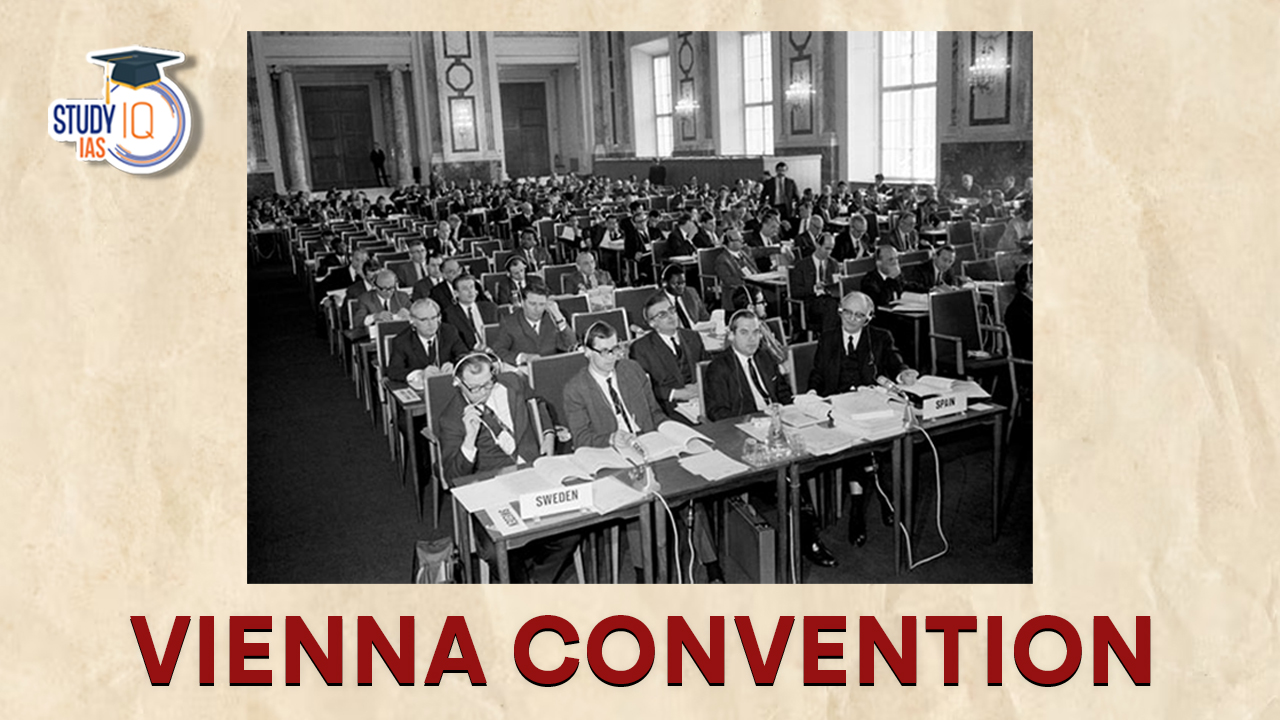Table of Contents
Vienna Convention
In 1985, the Vienna Convention was ratified, and it went into effect in 1988. It provides the framework for international efforts to protect the ozone layer, but it lacks legally binding CFC use reduction targets. The Vienna Convention for the Protection of the Ozone Layer and its Montreal Protocol on Substances that Deplete the Ozone Layer safeguard the earth’s ozone layer. The 197 parties that have ratified them make them the most ratified accords in UN history. You will learn about the Vienna Convention in this article, which will aid you as you study the Environment Syllabus for the UPSC Civil Service exam.
Vienna Convention Background
Studies conducted in the 1970s showed that man-made chlorofluorocarbons (CFCs) deplete and alter ozone molecules in the atmosphere. CFCs are stable molecules consisting of carbon, fluorine, and chlorine that have been widely used in products like refrigerators. The threat posed by vanishing ozone was brought to the attention of global climate issues by organizations like the World Meteorological Organization and the United Nations.
Science’s understanding of ozone depletion and its impacts on the environment and human health had advanced significantly by 1985. The Vienna Convention for the Protection of the Ozone Layer was subsequently developed in response. The concepts that numerous parties have agreed upon are laid down in this agreement, which serves as a framework convention.
What is Vienna Convention?
The principal compounds responsible for ozone depletion, CFCs, are not subject to any legally enforceable reduction goals. Later on, this would manifest as the Montreal Protocol. The Vienna Convention, which was the first of its kind to be signed by all participating nations and went into effect in 1988, was ratified by all nations in 2009. This indicates both the severity of ozone depletion at the time and the desire of nations all across the world to work together to address it.
The Convention sought to enhance global cooperation by exchanging knowledge regarding how human activities affect the ozone layer. The framers of the Convention believed that by doing this, officials would act to stop practices that contribute to ozone depletion.
Vienna Convention – Salient Features
- The Vienna Convention, which was signed by all of the participating member states and ratified by all nations on September 16, 2009, was the first of its type.
- The Montreal Protocol, which aims to reduce the production and use of (Ozone Depleting Substances) ODSs, was implemented in 1987 to support the Vienna Convention’s objectives of maintaining the ozone layer.
- The day the Montreal Protocol was made available for signatures and the Vienna Convention was universally adopted, September 16, 1994, was designated as Ozone Day by the UN General Assembly.
- Since it was signed in Kigali, the capital of Rwanda, the eighth Montreal Protocol amendment came to be known as the Kigali Agreement. By 2045, it seeks to reduce production and consumption of hydrofluorocarbons (HFCs) by 80% to 85% compared to baseline levels.
- The member nations get together every three years to talk about ozone layer studies and systematic observations.
- A forum called Ozone Research Managers was created after the Vienna Convention. It is a forum for professionals with expertise in ozone modification studies.
- A international fund is available to help developing nations migrate away from dangerous substances that deplete the ozone layer.
Purpose of Vienna Convention
The primary goal of the Vienna Convention is to prevent the ozone layer from being destroyed. On March 22nd, 1985, 28 nations approved the pact for the first time. The Vienna Convention and Montreal Protocol were ratified by all member states on September 16, 2009, making them the first treaties in United Nations history.
Vienna Convention and Conference of Parties
Every three years, a Conference of Parties (COP) is conducted. The 12th Conference of the Parties (COP) to the Vienna Convention took place in Tashkent, Uzbekistan, from November 23 to November 27, 2020. It was the most recent COP. Canada’s Montreal played host to the 11th COP to the Vienna Convention in November 2017. There are 198 signatories to the Vienna Convention. The United Nations Environment Programme (UNEP) is in charge of secretariat duties for the Convention.
Vienna Convention and Ozone Depletion
This illustrates how the ozone layer, which protects the atmosphere, is getting thinner. Ozone levels in the atmosphere naturally change with changes in temperature, weather, latitude, and altitude. Additionally, compounds expelled during natural occurrences like volcanic eruptions can have an appreciable effect on ozone levels. However, ozone depletion at the present time cannot be explained by natural events. The Antarctic ozone hole and the overall loss of ozone are the results of particular man-made substances, according to the scientific data.
These substances, which are industrial gases, are utilized in a variety of goods and services, such as aerosol sprays, freezers, air conditioners, fire extinguishers, and crop fumigation, and have been for many years. In the stratosphere, sunlight breaks down ozone-depleting substances (ODS) into halogen (such as chlorine or bromine) atoms, which then deplete ozone through a complicated catalytic cycle. Ozone depletion is highest in the South Pole, where exceptionally low stratospheric temperatures throughout the winter create polar stratospheric clouds. The ice crystals in these clouds enhance the amount of available surface area for chemical reactions, accelerating catalytic cycles.


 UPSC ESIC Nursing Officer Final Result 2...
UPSC ESIC Nursing Officer Final Result 2...
 UPSC CMS Admit Card 2025 Out: Download L...
UPSC CMS Admit Card 2025 Out: Download L...
 UPSC Study Material for Prelims & Ma...
UPSC Study Material for Prelims & Ma...





















